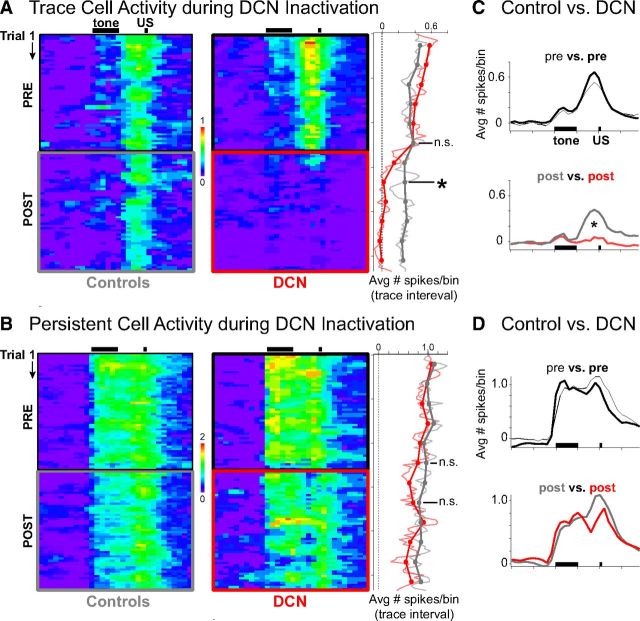Figure 9.
Pseudo-colored raster plots of average increases in activity (number of spikes/100 ms bin × trial) during sessions for persistent (A) and trace interval (B) cells recorded during control (left) and DCN infusion sessions (right). Black bars indicate CS and US presentation during trials. A, Trace interval cells appeared to show decreased activity within just a few trials after DCN inactivation. Right matrix, red box indicates inactivation epoch. The mean number of spikes observed during the trace interval was averaged for blocks of trials (right) and shows that trace cell activity was abolished to baseline by the second block (n = 16 cells, t = 0.16, p = 0.88 relative to baseline). *Significant difference between DCN and controls, n = 16 and 16 cells, t = 2.64, p = 0.018. B, Persistent cells showed gradually decreasing activity over the session, which was not affected by DCN inactivation (right: n = 8 and 14 cells, t = 0.49, p = 0.63). C, Temporal profile of mean spike response of trace cells over the entire trial (100 ms bins), averaged across preinfusion (top) or postinfusion (bottom) trials. Black bars indicate presentation of conditioning stimuli. The response profile of trace cells changed significantly during DCN inactivation (Kolmogorov–Smirnov test, D = 0.55, *p < 0.001), specifically during the trace interval, US, and post-trial time points, whereas CS responses were similar. D, Temporal profile of mean spike response of persistent cells over the entire trial during preinfusion (top) or postinfusion (bottom) trials. The profile during the postinfusion trials was not significantly different from controls (Kolmogorov–Smirnov test, D = 0.25, p = 0.14), suggesting that persistent responses were unaffected by DCN inactivation.

